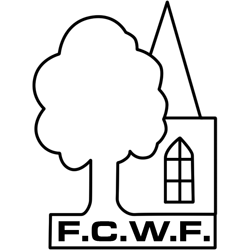Although the Hall has gone, it has left behind many reminders of the important role it played in shaping this beautiful Local Nature Reserve we now call Childwall Woods and Fields.
Below you will see a map to help you locate many of the places described in the narrative.
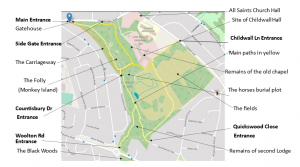
The site of Childwall Woods and Fields
As you enter Childwall Woods from Childwall Abbey Road main gate you will see the remains of the ‘moat’ ‘ravine’ or ‘carriageway’ as it is sometimes called.
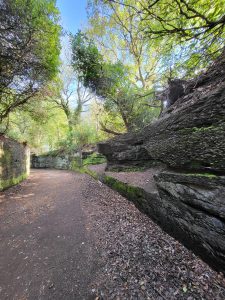
This is the long carriageway that was cut by Bamber Gascoyne Jnr to take the horse-drawn carriages of the day, through the grounds to the newly rebuilt Hall.
During the Access and Habitat Improvement Project which took place in 2021 the carriageway was scraped to make it passable on foot and became a beautiful route into the heart of the reserve.
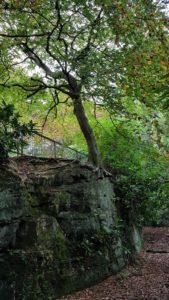
The carriageway was cut deep into the Bunter Sandstone and this has been identified as a regionally important geological site (RIGS) exposing the layers of sandstone during the excavation.
The carriageway is an interesting place to walk with some fine features along the way.
It curves around to the site where the Hall used to stand, now the home of Lime Pictures.
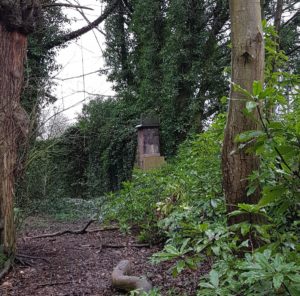
Hidden in the yew trees, not far from the end of the carriageway and next to the site of the old Hall, is the site of the family Chapel now covered by ivy which covers the arched door. Steps up from the Hall can still be found at the side of the wall. Well worth a look around as it has many secrets still to be uncovered if you have the time.
You will notice 2 sets of concrete steps here. These are nothing to do with the old chapel or the Hall but belonged to the Scout Hut that stood there before it was burnt down by vandals 50 years ago. One set of steps at each end.
The stables would have been just behind this.
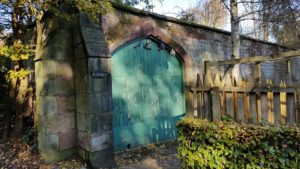
The stable block of the old hall is still quite visible inside the campus of Lime Pictures, who kindly allowed this door to the stables to be photographed for our website. Not visible in the woods but just on the other side of the fence in our neighbour’s yard.
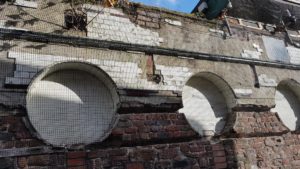
Echos of the grandeur of the stable block can be found in the circular windows that remain on the site, tiled at a time when the stables became a garage and now netted due to their fragile condition.
Again thanks to Lime Pictures for letting us use these images from their campus
Next to the carriageway is a sunken area with steps down, opening up to expose a large sandstone outcrop known locally as ‘Monkey Island’.
Many stately homes have a Folly perched up high on a hill to show their wealth. In the grounds of Childwall Hall, the Folly is cut deep into the rock creating a sunken garden used by the residents of the hall in its glory days. Part of the woodland walk past variegated oaks and holly trees. A wide set of steps to show its importance.
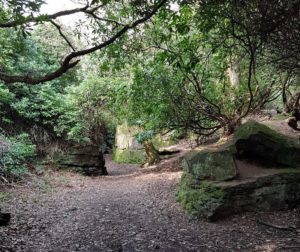
The Folly
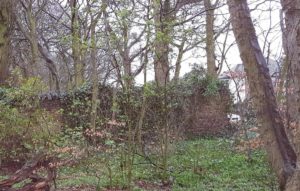
Throughout the northwest part of the woods, there are glimpses of sandstone walls that were once associated with the hall and its outbuildings. This one is near the Countisbury Drive Entrance.
Below are the remains of a building adjacent to the wall. The burial place for the beloved animals that had once lived on the estate, and it is thought it was created to honour the beloved horses who died in a fire in the stables and were buried here, along with the dogs from the hall. A suitable burial place for the animals belonging to the family.
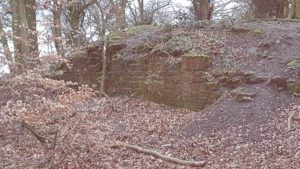
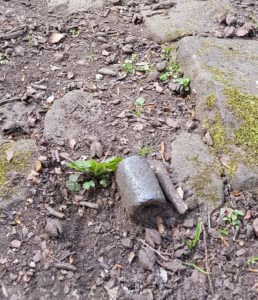 If you look carefully on the ground and underneath the leaf litter you can find a metal relic of a gate. No one can explain what it is but it shows us there was something across the path in the past. A gate maybe?
If you look carefully on the ground and underneath the leaf litter you can find a metal relic of a gate. No one can explain what it is but it shows us there was something across the path in the past. A gate maybe?
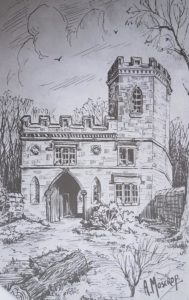
This is a copy of an original watercolour by A. Moscrop depicting the second gatehouse different to the one on Childwall Abbey Road but still reflecting the castle-like design of the Hall. This was kindly donated to FCWF by Ray Lowe whose father William ‘Billy’ Lowe was born in this lodge when his grandfather worked in the stables.
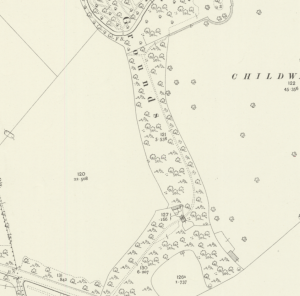
The map from 1904. Notice the footprint of the second lodge with the path going through it.
The OS map for 1904 shows a building with the path going through it near the Woolton Road entrance to the woods.
There is just one photograph of the second lodge, shown earlier on this page and with the path going through it would have been a perfect fit for this footprint.
The walls can be found today, now between 2 paths which have replaced the one shown on the map. They are heavily disguised with a century of leafmould and ferns but are there for those who want to find them.
The woods themselves owe their diversity and beauty to the planting that went on by the original owners of the hall. Some of the specimens originally planted are now huge mature trees and bushes, homes for bats and woodpeckers amongst many other creatures great and small.
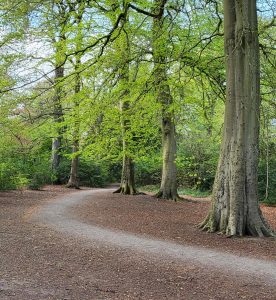
These beautiful old beech trees standing in a row are close to the site of the old Hall and this wonderful gnarled sweet chestnut (below) is at the end of the carriageway and was certainly around to witness the comings and goings of the Gascoyne family.
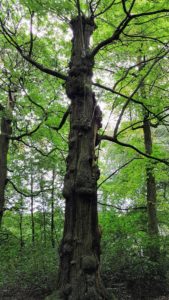 But it was most probably the wealthy shipping merchants who brought in the rhododendrons and other rare imported trees.
But it was most probably the wealthy shipping merchants who brought in the rhododendrons and other rare imported trees.
Most probably the Brocklebanks, father and son, who were both tenants at Childwall Hall were responsible for many of the specimens on the ornamental woodland walk. As the owners of a shipping line, they would have been able to import trees and plants quite easily and their wealth would have made it possible for them to buy rare cultivars and grafted trees.
150 years later, with no wealthy tenants to maintain the site the Rh ponticum has filled every space, hiding rare grafted trees such as the variegated oaks and the ancient hybrid rhododendrons.
Maybe there are still other gems waiting to be discovered amongst the ancient rhododendrons to surprise and delight the walker who happens to look carefully enough. Maybe you have spotted the variegated holly and thick ropes of honeysuckle by the folly.
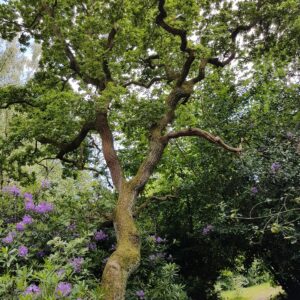
There were 2 rare Variegated Oak trees, maybe 150years old, on the site of Childwall Woods. Rare, as there are only 69 of these beautiful hybrid trees in the whole of Britain and Ireland. Sadly the larger tree was blown over during storm Arwin in November 2022. For more information visit the Champion Tree page.
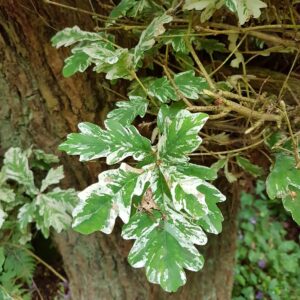
Artefacts found on the site
Photos are shown with the kind permission of Pete, who found all of these items on the site using a metal detector.
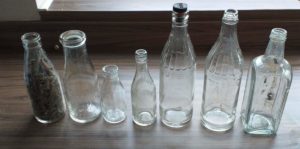
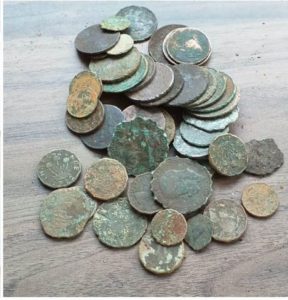
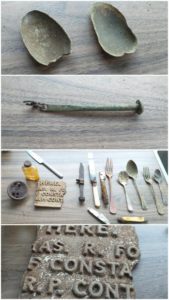
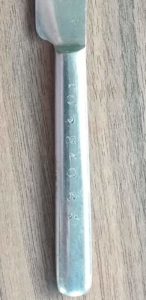
The handle is engraved with the number of the serviceman who owned it.
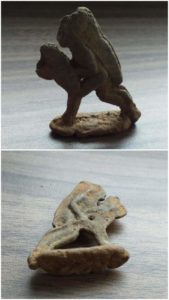
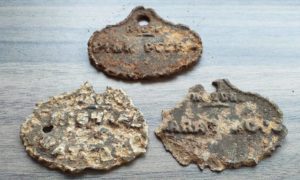
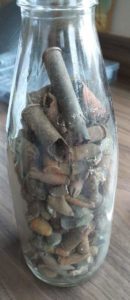
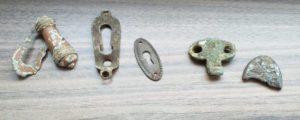
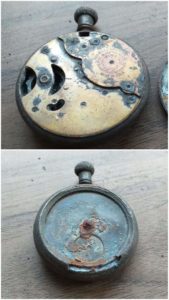
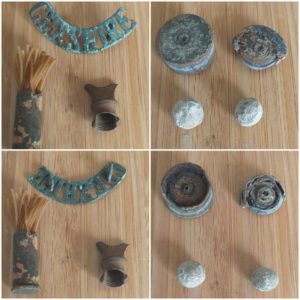
A Cheshire Regiment shoulder badge old shotgun and musket shells, part of an old whistle and a 1942 bullet casing with the primer still in.
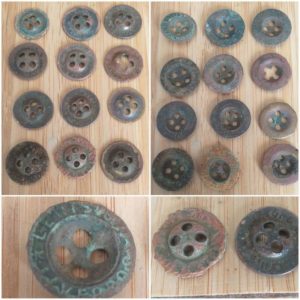
Old buttons, some military. Many are Birmingham, Liverpool and London made. The Royal Crest on one shows it to be a pre-WW2 issue button.
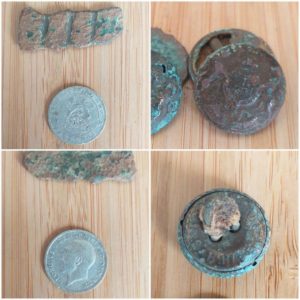
More of Pete’s finds to come as they are unearthed.
____________________________________________________________________________________
Author: B Cameron
Photographs are the author’s own unless stated otherwise.

